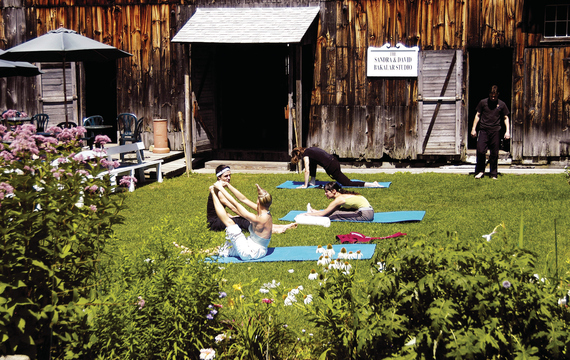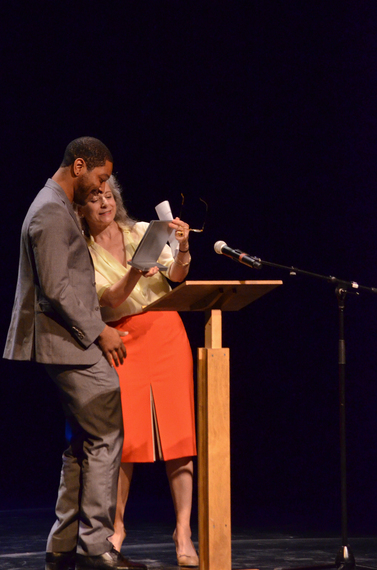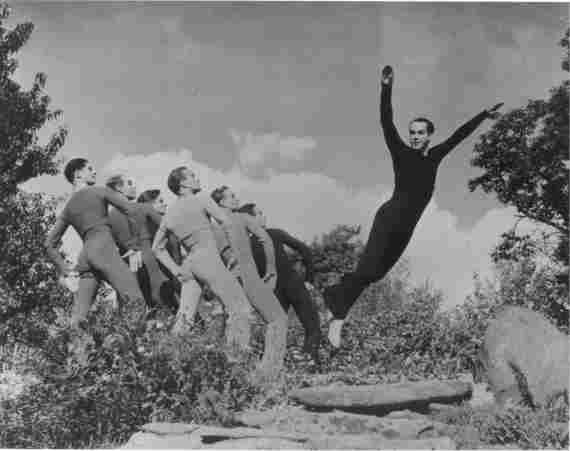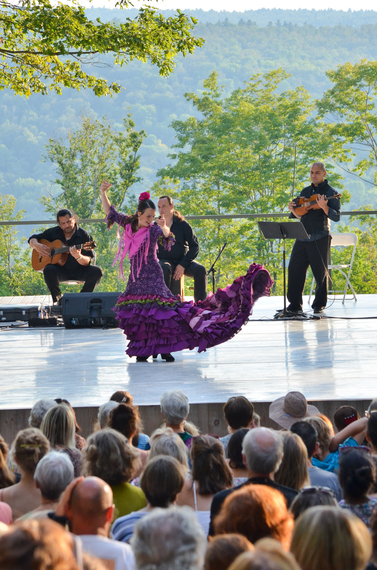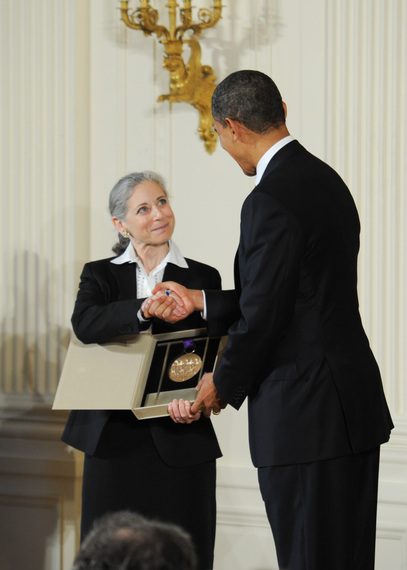Jacob's Pillow Executive and Artistic Director Ella Baff; photo credit: Christopher Duggan
Ella Baff tiptoed through a door and into the barn. A knot of musical theater students warmed their vocal cords before rehearsal, trilling off scales like they were second nature. Behind, an engaged instructor in a black bowler hat marked choreography across the marley floor, his pupils glued to the mirror. Despite a promise of sweat in the near future, the air smelled crisp, the scent of wood and trees wafting in the wind.
Baff smiled with aquamarine eyes that shone from youthful ebullience. Her typically restless countenance relaxed, and she stood, admiring her work. For 17 years, she had devoted her livelihood to fostering a serene environment for students and artists like the ones inside her barn-studio. She was the selfless facilitator of a greater design: innovation in dance.
"It's just so gratifying to be able to find exceptional talent, and be able to say, 'I want to help you, really,'" Baff said. "'I want to help you, and I have a venue through which to do that.'"
Baff, the Executive and Artistic Director of Jacob's Pillow, is leaving Becket, Massachusetts for New York to serve as the Senior Program Officer for Arts and Cultural Heritage at the Andrew W. Mellon Foundation. One can infer that the move is bittersweet for Baff, whose love for her current role is palpable. She's pleased by what she's attained in the past two decades at the United States' leading dance festival, and her satisfaction is well deserved.
Tea Garden, 2005; photo credit: Yana Kraeva
When Baff first arrived at the Pillow, its infrastructure seemed tentative at best. The space had evaded foreclosure thanks to valiant efforts by her predecessors, but it was nothing like the landscape visitors find today: a green paradise with looming trees on either side and quaint cabins filled with live performance. Under Baff's direction, the area expanded from 163 to 225 acres, and the facilities underwent significant renovations. Now, Jacob's Pillow is pristine yet welcoming -- a haven for city dwellers who need to remember what the earth looks like without concrete.
But while Baff's physical imprint on the property has been huge, it's her realized vision of Jacob's Pillow as a breeding ground for art that has made the largest impact on dance.
"What is my big accomplishment, or what am I most proud of?" she asked.
I'd definitely put on the list being in a position to help introduce artists who were previously under-recognized or not known to the public, to the media, and support[ing] them along the way so that they really, really reach another level of visibility in their careers and in their own artistic development.
2012 Jacob's Pillow Dance Award recipient Kyle Abraham and Executive and Artistic Director Ella Baff; photo credit: Taylor Crichton
Baff has catapulted some of the most distinguished personalities in the industry to fame. Kyle Abraham performed at the Inside/Out stage long before he was awarded the MacArthur Fellowship in 2013. Michelle Dorrance's tap routines were spotted as more than mere entertainment by Baff, who ushered Dorrance into the spotlight. And Jessica Lang premiered her troupe at Jacob's Pillow before anyone recognized her name.
"When Jessica Lang first came to the Pillow years ago and was just starting her company, people called the box office and said, 'I didn't know that Jessica Lange the actress had a dance company,'" Baff joked.
I mean, no one knew who she was! Now, we're selling out a two-week run at the Doris Duke Theatre and people say, 'When is Jessica Lang coming back?' And she's touring all over, and getting commissions, and everything. I'm not saying we're the cause of that. I mean, I know that we helped.
Appreciation abounds for the opportunities Baff has afforded to up-and-coming choreographers and directors. Lang herself claimed that, "As an artist, I owe a great debt of gratitude to Ella for her interest and belief in me, my work, and her care of my company." Tina Finkelman Berkett, Co-Founder and Artistic Director of BODYTRAFFIC, holds Baff in similar esteem.
"Ella is a rare gem in our community: she was among the first to recognize our work and go out of her way to make sure it would be shared," she said. "Through her ongoing mentorship and personal investment, she has undoubtedly played a huge role in the success of BODYTRAFFIC, and the Los Angeles dance scene at large."
Throughout Baff's time at Jacob's Pillow, she has pushed to accommodate more women in positions of authority. Despite dance's primarily female demographic, the majority of the community's prominent choreographers and artistic directors are male. Women tend to be muses instead of masters, despite the fact that some of the most capable dance minds are women (think Emily Molnar at Ballet BC, or Andrea Miller with Gallim Dance).
"I try to present women choreographers," Baff said. "I consider the gender politics of all of this, but I don't let it dominate my decision-making. But I absolutely consider it, and I feel especially good when we're able to support women choreographers or women artistic directors of companies."
Still, Baff's principle agenda is to showcase quality work. After all, she must choose 52 companies to invite -- with the entire dance population at her beck and call -- and her objective is to provide wonder for her audiences, who drive to the Pillow to view the artistic vanguard. She's most excited when she finds something novel that defies categorization or allusion to another era.
"It doesn't look like anything else," she explained.
Yes, I can pull strings and strands from different places. It kind of resides in the world of dance theater, a Euro-something that is, three generations later, influenced by Pina Bausch. But it doesn't look at all derivative. It looks fresh and original, and it just hits your eyeballs in a very immediate way. And I think the phenomenon of the new -- the phenomenon of innovation -- is really fascinating.
Ted Shawn and His Men Dancers in Dances of the Ages, ca. 1938; photo credit: Shapiro Studio
Baff honed her curatorial skills as a child, when she and her sister were required to study an instrument. She first played the piano but eventually transitioned to the violin and harp. With music ambient, she would dance around her home, until she wandered into a studio as an adolescent. Martha Graham lived in her childhood apartment building, and Graham technique was the first she learned. Later, she took class at the Cunningham Studios and with icons like Gabriela Darvash and David Howard. She lived in New York City through the epoch of Judson Church -- through Balanchine and Robbins -- and Manhattan's finest were at her disposal as she became a dance dilettante.
"I was a real dabbler," she laughed. "I would take classes in anything. Balinese dance. African dance. I had a very big appetite, or curiosity to see, 'What are those different forms like to put on my body?' I never had aspirations, I don't think I was very good anyway. But I loved being a student."
A Palo Seco performing as part of the free Inside/Out performance series, 2012; photo credit: Taylor Crichton
Her varied technical training gave her an equally diverse taste that has influenced the Pillow's bills for 17 years, often to much acclaim. Indian classical dance, ballet, contemporary, Korean dance -- nothing is off limits, which makes her a godsend for artists. She's the friend who helped them along the way, supporting their mission because she genuinely understood its value.
"I first met Ella in 2003 when she agreed whole-heartedly to shepherd an experimental company I was forming," Pacific Northwest Ballet Artistic Director Peter Boal said.
Her encouragement in me and in so many others over the past 17 years has significantly helped to expand the world of dance. The Pillow has thrived under her leadership in all areas, from archives to education, and from repertory to reputation. We are all so grateful for Ella's profound contribution to all of our lives.
Under Baff, the Pillow has been recognized for its significance to the American cultural tapestry. In 2003, the site earned national landmark status, not only as a now 83-year-old dance refuge founded by Ted Shawn, but also as a former station on the Underground Railroad. Baff strove to incorporate that legacy in the location's modern fabric with Joanna Haigood's Invisible Wings, a piece that uses the Pillow's ecology to reconstruct vignettes from African American society in the 1850s.
Generally, Baff's a sucker for history. She's especially fond of the Pillow's first known settlers, the Carter family, whose 1790 farmhouse hosts her private sitting room and office. It was the Carters who named the land after a passage in Genesis; a nearby rock represents Jacob's pillow, and the closest street is aptly named Jacob's Ladder.
"There's something in the DNA of any place, and if you're lucky enough to have some relationship to the lineage of a place, it can be very powerful, very motivating," she said.
Perhaps it's this motivation that inspired Baff to rally. Over 17 years, she digitalized thousands of images and videos from archives that had been woefully disregarded, establishing an impressive collection of dance research and resources for her summer scholars. She launched the Pillow's first endowment. She expanded its summer intensives for aspiring dancers, who benefit from exposure to top choreographers and directors in their field. And she incorporated free programming, including talks and performances at the Inside/Out Stage, an outside platform with the Berkshires and blue, open sky as a backdrop.
"What is that about? It's about giving access to people no matter what their economic circumstances are," Baff said. "All of these multiple entry points to become less anxious [and] more familiar with what the art form is about are very, very important, I think, for building audiences in dance."
Jacob's Pillow Patrons, 2011; photo credit: Cherylynn Tsushima
As mentioned in The Atlantic's "The Death of the American Dance Critic," U.S. attention to dance has dwindled. Though Misty Copeland may have captured the intrigues of millions with her Under Armour commercial, few families actually venture to the theater. Most aficionados cite dance's elusive, interpretative essence as the problem -- the public is afraid of being out of the loop, or seeming unintelligent because they don't grasp the intent behind every motion.
"When abstract expressionism first came about, people would look at a Jackson Pollock painting and they would say, 'Oh, my five-year-old could do that,'" Baff explained. "But their five-year-old didn't conceive that, for one thing. And they were made very, very uncomfortable by confronting an object that had no narrative in words. I think that's a lot of what people feel with dance."
"What I find really interesting about dance is that you're not often told what to think and how to experience it, but I think that also makes people anxious," she continued. "They want to be told."
Baff's dedication to outreach and archival preservation resulted in a call from Rocco Landesman, the then-Chairman of the National Endowment for the Arts, in 2011. "My assistant came into my office and said, 'Rocco Landesman's on the phone, he wants to talk to you,'" Baff reminisced. "And I thought, 'Well, what could that be about? Why is he calling me? Do we have a problem with our grant we submitted?' I mean, I couldn't imagine. He said, 'Are you sitting down?' I said, 'Not now, but I will.'"
Once she settled in a chair, he told her that the Pillow had been granted a National Medal of Arts by President Barack Obama.
"Well of course, I just about passed out," she said. "I had no idea this was happening behind the scenes."
Photo credit: Ruth David, courtesy of the National Endowment for the Arts.
Baff is humble, but the distinction shouldn't have been a surprise. The labor she has pumped into the Pillow is unparalleled, and it merits acknowledgment.
"Ella Baff turned Jacob's Pillow into a nuclear site of creativity with genius programming, brilliant training, astonishing archives, and clusters of bright minds and talents," LINES Ballet Artistic Director Alonzo King said. "For seventeen years, she brought the best of the dance world, both known and newly discovered, to leave their footprint on that historic landmark."
As Baff departs for the Mellon Foundation, she's regarded as one of dance's heroines. Artists bend over backward to comment on her wisdom and kindness. Patrons gush over the insight of the festival's season, even if they don't know who devised it. Through patience and tender care, Baff has morphed Jacob's Pillow into a hopeful beacon for dance in the United States.
"I'm proud of many things that have been achieved over a period of time," she said, grinning. "Because sometimes, it takes a period of time to achieve big things."

